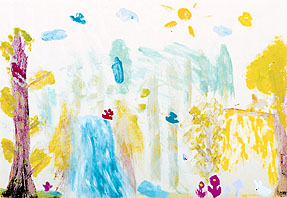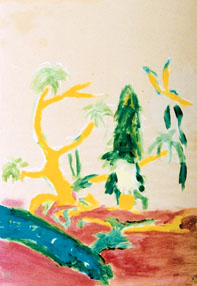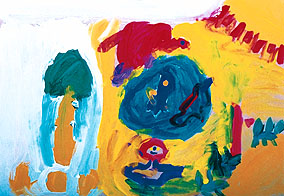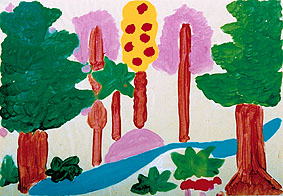 |
In this open spacious
forest the mark making is somewhat underpainted. There is an attempt at inhabiting
the forest slightly. The sense of tree form is there in the vertical trunks and
the variety of attempts to render different kinds of foliage. There is use of
fingers, rotating sponges and brush dabbing. The painting is consistent in that
it is airy and spacious and somewhat tentative. What seems to be missing is a
rich commitment to pigment and perhaps the compositional arrangement of things
other than the flanking trees in the central foreground. |
 |
Only one recipe has
been used for green in this painting, and it is used all over. The snarly and
tufty topped tree forms are interesting. What is missing is a sense of density
and forest. This is a careful painting of a couple of trees and a foreground river
that seems to disappear on us. The area of painting that might have succeeded
in giving the sense of forest is yet to come and there is not any real indication
from the student as to how that would be resolved. The colour range used so far
is quite limited. |
 |
Here are three very
similar trunks with some sense of vines. There are some stereotype birds and a
string of sky. There is a series of intervals between each trunk which vary the
effect of shape and size and this adds to a sense of forest depth rather than
to a sense of regimentation. So compositionally this painting is well worked out.
The background has been painted by filling in between the trunks with pale colour
(it is not unpainted paper) so the entire surface has been painted. What is missing
is a sense of anything beyond the trunks, so there isn't really a believable sense
of forest and recession of space. It is largely through the white bird forms across
the front of the trees that any sense of space is achieved. |
 |
This painting is fairly
limited in its symbol forms, its lollipop trees and sun in the right hand corner,
and yet it is well painted in the sense that the paint has actually been used
to communicate area, and there has been colour mixing going on. The space is filled
and when you look closely at the main symbols of person, a pond with fish in it
and creatures at the side, it is seen that they are fairly schematic. They are
line drawings in paint. It is the background having been attended to so fully
that turns this from a drawing into a painting. |
 |
This is a painting
that within the time available is relatively complete and well composed. There
are some nice textural effects in the foliage, and a variety of tree forms. However,
variety doesn't always make for forest, and the strong central tree with its yellow
and red blobs has a way of dominating the picture by both position and colour.
The fern forms are repeated shapes. There is a believable sense of space with
the water diverting behind the trees that are further back. The effect is to give
a sense of the river receding away from us. The challenge for this artist would
have been to have completed work and exaggerate some of the textural information
hinted at in one colour. |
 |
This is quite a strong composition
with a footbridge over the river, and although the symbols are not well developed,
the artist has managed to compose a picture that goes across an entire page to
fill the space and give a sense of involvement. It is more the sense of the river
coming down towards us that the student has evoked. The tree forms are fairly
stereotypical with strong rectangular trunks and triangles or circles on top.
There has been some attempt at shading and texture. Probably what is most inventive
here is the mixing of the range of browns with the intent of showing form through
light and dark. An image has been chosen that evokes bush and a sense of walking
across waterways. |





